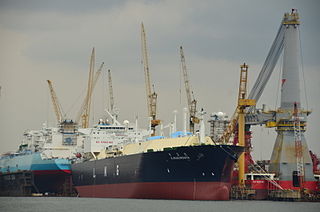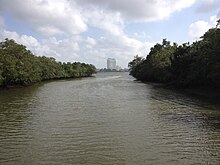
Lim Chu Kang is a planning area located in the northwestern part of the North Region of Singapore, bordering the Western Water Catchment to the west and south, Sungei Kadut to the east and the Straits of Johor to the north.

The Bukit Timah Nature Reserve is a 1.7-square-kilometre (0.66 sq mi) nature reserve near the geographic centre of Singapore, located on the slopes of Bukit Timah Hill, the country's highest natural peak standing at a height of approximately 165 metres (541 ft), and parts of the surrounding area, located actually in Bukit Panjang. The nature reserve is about 15 kilometres from the Downtown Core, Singapore's central business district (CBD).

The Central Catchment Nature Reserve is the largest nature reserve in Singapore, occupying 2880 hectares. Forming a large green lung in the geographical centre of the city, it houses several recreational sites, including the Singapore Zoo, the Night Safari and the River Safari, as well as several newer facilities built to encourage public appreciation of the reserve, such as the HSBC TreeTop Walk. The reserve sits within the boundaries of the Central Water Catchment. It is one of the four gazetted nature reserves in Singapore. The other three are the Labrador Nature Reserve which was gazetted since 1 January 2002, Sungei Buloh Wetland Reserve and Bukit Timah Nature Reserve. All four nature reserves along with the parks are protected under the Parks & Trees Act 2005.
The Nature Society (Singapore) (NSS) is a non-government, non-profit organisation centered towards the preservation and appreciation of Singapore's natural heritage, as well as that of the surrounding region. Run by volunteers, the NSS depends financially on its members' contributions as well as companies, institutions and individuals.

The North Region of Singapore is one of the five regions in the city-state. The region is the second largest region in terms of land area, and has a population of 582,330. Woodlands is the regional centre and also the most populous town with 255,130 residents living in the area. Comprising 13,500 hectares of land area, it includes eight planning areas.

The Singapore Green Plan (SGP) was created in 1992 to ensure that the economic growth model of Singapore does not compromise the environment. The SGP sets out the strategies, programs and targets for Singapore to maintain a quality living environment while pursuing economic prosperity. The focus areas in the SGP are led by a main coordinating committee and respective action program committees. Since 1992, the SGP has been continuously updated to ensure its relevance, releasing SGP 2012 in 2002 and SGP 2030 in 2021. The United Nations (UN) Sustainable Development Goals (SDG) are correlated or mapped to the SGP.

Ras Al Khor Wildlife Sanctuary is a wetland reserve in Dubai, renowned for attracting large numbers of migratory birds. It is also home to a large population of crustaceans, small mammals, and fish. It was the end of Dubai Creek before the construction of Dubai Canal, hence the Arabic name which literally means "the head of the creek".
Singapore has about 65 species of mammals, 390 species of birds, 110 species of reptiles, 30 species of amphibians, more than 300 butterfly species, 127 dragonfly species, and over 2,000 recorded species of marine wildlife.

Kent Ridge Park is a 47-hectare public park located in Kent Ridge, Singapore, between the National University of Singapore and the Singapore Science Park. Due to its undisturbed habitat and abundant plant life, it is a popular venue for bird-watchers and eco-tourists.

Singapore has a wide variety of flora. Plants are mainly used to beautify the landscape of Singapore. The national flower is a hybrid orchid, Vanda Miss Joaquim.

Newport Wetlands is a wildlife reserve covering parts of Uskmouth, Nash and Goldcliff, in the south-east of the city of Newport, South Wales.
Choa Chu Kang Road is a road in Singapore in two sections.

The wildlife of Singapore is surprisingly diverse despite its rapid urbanisation. The majority of fauna that still remains on the island exists in various nature reserves such as the Bukit Timah Nature Reserve and the Sungei Buloh Wetland Reserve.
CPG Corporation is an infrastructure, building management, and consultancy services company in the Asia Pacific.

The Singaporean government has established four nature reserves in Singapore. They are the Bukit Timah Nature Reserve, Central Catchment Nature Reserve, Labrador Nature Reserve, and Sungei Buloh Wetland Reserve.
The Cashin House, known as The Pier, is a former residence of the Cashin family extending out to sea in Lim Chu Kang, Singapore. The house on the pier was restored and became a new visitor gateway to the western part of Sungei Buloh Wetland Reserve known as Lim Chu Kang Nature Park.


















